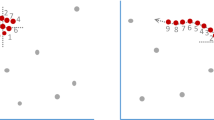Abstract
Time series are often generated by continuous sampling or measurement of natural or social phenomena. In many cases, events cannot be represented by individual records, but instead must be represented by time series segments (temporal intervals). A consequence of this segment-based approach is that the analysis of events is reduced to analysis of occurrences of time series patterns that match segments representing the events.
A major obstacle on the path toward event analysis is the lack of query languages for expressing interesting time series patterns. We have introduced SQL/LPP (Perng and Parker, 1999). Which provides fairly strong expressive power for time series pattern queries, and are now able to attack the problem of specifying queries that analyze temporal coupling, i.e., temporal relationships obeyed by occurrences of two or more patterns.
In this paper, we propose SQL/LPP+, a temporal coupling verification language for time series databases. Based on the pattern definition language of SQL/LPP (Perng and Parker, 1999), SQL/LPP+ enables users to specify a query that looks for occurrences of a cascade of multiple patterns using one or more of Allen's temporal relationships (Allen, 1983) and obtain desired aggregates or meta-aggregates of the composition. Issues of pattern composition control are also discussed.
Similar content being viewed by others
References
Agrawal, R., Psaila, G., Wimmers, E.L., and Zait, M. Querying Shapes of Histories. In Proc. of the 21st Int'l Conference on Very Large Databases, Zurich, Switzerland, Sept. 1995.
Allen, J.F. (1983). Maintaining Knowledge About Temporal Intervals. Communications of the ACM, 26(11), 832–843.
Berndt, D.J. and Clifford, J. (1996). Finding Patterns in Time Series: A Dynamic Programming Approach. Advances in Knowledge Discovery and Data Mining, 229–248.
Edwards, R.D. and Magee, J. (1997). Technical Analysis of Stock Trends, 7th edn. AMACOM.
Faloutsos, C., Ranganathan, M., and Manolopoulos, Y. (1994). Fast Subsequence Matching in Time-Series Databases. In Proc. SIGMOD.
Fayyad, U.M., Piatetsky-Shapiro, G., Smyth, P., and Uthurusamy, R. (1996). Advances in Knowledge Discovery and Data Mining. MIT Press.
Informix Software Inc. (1994) Informix TimeSeries DataBlade Module User's Guide Version 3.1.
Knuth, D.E. (1988). The Texbook: A Complete Guide to Computer Typesetting With Tex. Addison-Wesley Pub. Co.
Lin, L. and Risch, T. (1998). Querying Continuous Time Sequences. VLDB.
Mecca, G. and Bonner, A.J. (1995). Sequences, Datalog and Transducers. PODS, 23–35.
Motakis, I. and Zaniolo, C. (1997). Temporal Aggregation in Active Database Rules. SIGMOD Conference, ACM SIGMOD Record, 26(2), 440–451.
Perng, C.S. and Parker, D.S. (1999). SQL/LPP: A Time Series Extension of SQL Based on Limited Patience Patterns, DEXA 1999. An extended version is available as Technical Report 980034 UCLA, Computer Science.
Schmidt, D. et al. (1995). Time Series, a Neglected Issue in Temporal Database Research? In J. Clifford and A. Tuzhilin (Ed.), Recent Advances in Temporal Databases, Workshops in Computing Series (pp. 214–232). Springer.
Segev, A. and Soshani, A. (1993). A Temporal Data Model Based on Time Sequences. In A.U. Tansel et al. (Eds), Temporal Databases. Benjamin/Cummings.
Seshadri, P., Livny, M., and Ramakrishnan, R. (1994). Sequence Query Processing. In Proceedings of the ACM SIGMOD Conference on Data Management.
Seshadri, P., Livny, M., and Ramakrishnan, R. (1995). SEQ: A Model for Sequence Databases. In Proceedings of the IEEE Conference on Data Engineering.
Shatkay, H. and Zdonik, S.B. (1996). Approximate Queries and Representations for Large Data Sequences. ICDE 536–545.
Snodgrass, R.T. (Ed.) (1995). The TSQL2 Temporal Query Language. New York: Kluwer Academic Publishing.
Author information
Authors and Affiliations
Rights and permissions
About this article
Cite this article
Perng, CS., Parker, D.S. Temporal Coupling Verification in Time Series Databases. Journal of Intelligent Information Systems 15, 29–49 (2000). https://doi.org/10.1023/A:1008777711333
Issue Date:
DOI: https://doi.org/10.1023/A:1008777711333




